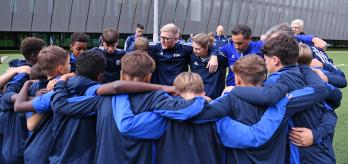Professor Oliver is an expert in long-term development in young athletes. In this fascinating session for Science Explained, he provides a detailed summary of the different stages children's brains and bodies go through as they mature, exploring the links between maturity, physical fitness and the ability to learn new skills. Later, he discusses a variety of scientific models of athlete development, and considers what, when and how coaches should be coaching young players to help them maximise their potential. The session is followed by a Q&A, hosted by Dr Paul Bradley.
Explain how growth and maturation affect young athletes and suggest how coaches can tailor their training longitudinally to take account of these effects.
Children are not just mini-adults: their training should take into account their specific needs. Young children can pick up skills very quickly, but their fitness improves at a relatively slow rate. On the other hand, puberty coincides with an increase in muscle mass and fitness. These development changes have major implications for training.
Coaches need to be aware of how growth affects children's physical fitness, coordination and neuroplasticity, and should look to tailor their training with these factors in mind. Doing so will help them maximise their players' potential and reduce the risk of injuries.
Watch video
Read summary
Part 1: Growth, maturation and neuroplasticity
Professor Oliver begins his presentation with a discussion around growth and maturation. As he is at pains to stress, children are not just mini-adults: they require tailored training programmes that meet their needs and take account of the natural variations in maturity that can give rise to selection biases (see Professor Sean Cumming's recent session for a more detail on this topic). These programmes need to cater for physical growth and make the most of children's ability to learn new skills much faster than adults.
Part 2: The link between puberty and injuries
In this section, Professor Oliver explains that the adolescent growth spurt starts in the long bones in the arms and legs, and this has significant effects on the training pitch. Rapid growth may temporarily disrupt coordination which is why some teenage footballers can seem to "lose their touch" and move more awkwardly. Moreover, as the bones lengthen, they pull on the muscles, which can cause tightness and leave young athletes more susceptible to growth and overuse injuries. Coaches need to show an awareness of these factors.
As long as a child is physically active, the onset of puberty will coincide with a major improvement in physical fitness. However, it is widely believed that coaches can supercharge this effect by exposing young athletes to the right kinds of exercise at the right times, and it is part of a coach's role to find the right mix of activities. As Professor Oliver explains, evidence and his experience suggests that football training can help improve aerobic fitness, but may have less of an effect on attributes like agility.
Part 3: Models of athlete development
Professor Oliver introduces four scientific models of athlete development, drawing out the similarities and differences between them and examining their implications for training. These models can also be useful for discussing the issue of specialisation in sport; as Professor Oliver notes, specialising in a specific sport at a very early age is not necessarily the key to success at the elite level. For more on this topic, see previous presentations by Professor Joe Baker and Dr Sandy Mosher.
Part 4: What to train and when
To finish, Professor Oliver recaps his presentation by attempting to answer an ostensibly simple question: what training should coaches be providing to young athletes? The answer is more complicated than it looks, and ultimately depends on the position you want a footballer to be in as they reach adulthood. Whatever the ultimate aim, developing a training programme that takes each individual's physiological development into account can help athletes stay healthy and make the most of their potential.
Q&A
01:15
How can practitioners measure maturation effectively, and are there are specific issues related to long-term athlete development that we need to take into account when measuring?
04:56
Is it preferable for young players to mature early or late?
08:08
Is it safe and advisable for young players to be doing resistance training and power-based sessions? What is the evidence base around this issue?
11:46
How important is it to consider growth and maturation when designing training programmes for young footballers.
14:35
Are there any key differences in how practitioners should approach physical development in girls and boys?
17:56
What are the risks of early specialisation and how can we mitigate them?
21:43
There is a lot of reductionism in sports science. How would you integrate physical development with the technical and tactical development of players from a sports science point of view.
26:34
You mentioned neuroplasticity and the way this accelerates in early childhood. How do practitioners (and indeed parents) maximise that period for children's development?
30:08
What are your thoughts on bio-banding for competition and potentially for training, too? What influence might that have on long-term planning for young players' development?
33:16
If you could give practitioners one piece of advice on this topic, what would it be?















